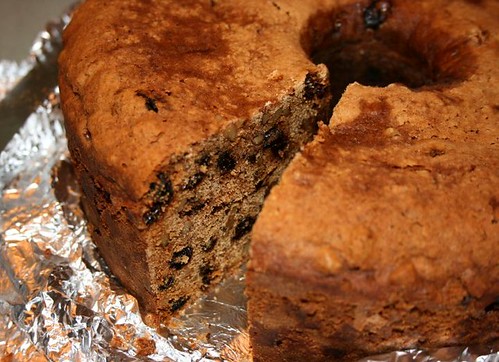That night I unwrapped the cake and cut off a slice. It tasted fresh and good even though it was 2.5 years old.
By now some of you are undoubtedly scratching your head and wondering what the heck pork cake could possibly be. For my family, pork cake is *the* Christmas cake we eat every year. It's a dark, dense cake with a fine texture and a crunchy crust, studded with walnuts and raisins, and flavored with wine or what have you. The cake has always reminded me something of a pound cake crossed with a white fruit cake. It's sweet but not too sweet, and goes well with a glass of milk or a cup of coffee. We often have it with fruit salad made from fresh apples, grapes, oranges, canned pineapple, and sometimes flaked sweetened coconut.
My paternal grandmother has made these cakes as long as I can remember, maybe as long as my dad can remember. It's an old recipe, one that actually includes pork fatback but no dairy or eggs. Food historians may be reminded of recipes from the war years, when butter was in short supply, or even during the Depression when you made do with whatever odd ingredients you might have on hand and didn't have to buy. However, I suspect this recipe is much older than that, stretching way back into the Appalachian past, from maybe the 1700's or even older.
While a dessert made from pork fatback may sound terribly odd these days, pork cake is clearly related to recipes for the mincemeat pies of early England in the 15th, 16th, and 17th centuries. I imagine that my American ancestors made pork cake to take advantage of the abundance of pork fat available in the fall after the hogs were slaughtered. I'm sure just black walnuts would have been used as they were free in the woods for the price of collecting and cracking open. Molasses may have been used instead of brown sugar. Apple cider, apple jack, or maybe even moonshine flavored with fruit may have been used to moisten and flavor the cake while it was stored. (My grandmother herself uses Ripple wine.) This cake is a good keeper and would easily be good at Christmas even though it had been baked a month or so earlier.
Clearly this recipe is not meant for those following kosher, halal, or similar dietary rules. And I was surprised to learn via Google that Wallis Warfield, who became the Duchess of Windsor, was apparently a fan of pork cake, with a recipe variation found here. The reviewer of the Duchess's recipe reported that she could taste a pronounced pork flavor in each bite, but that's never been an issue with my grandmother's cakes.
So here is my grandmother's recipe for pork cake in all of its quirky glory. I should tell you that 1) Granny never uses a printed recipe as she cooks from her memory, and 2) I haven't used this recipe myself. I should also add that I don't think Granny makes her cakes with the fatback that has been salted. I don't think I'd try substituting lard for the fatback as lard melts much more easily and doesn't have the same texture as the fatback.
Pork Cake (makes two cakes)
8 cups flour
1 TBS cinnamon
1 TBS nutmeg
1 TBS baking soda
1 pound pork fatback, ground fine
1 pint perked, strong coffee
4 cups brown sugar
1 pound raisins
1 pound chopped English walnuts
1 cup chopped black walnuts
Preheat oven to 350 degrees. Sift flour, spices, and baking soda together and set aside. Combine ground fatback, hot coffee, and brown sugar. Gradually add flour mixture to fatback mixture and mix well. Batter will be thick. Mix in raisins and nuts until well incorporated into the batter. Spoon batter into two greased tube pans. Bake for about two hours or until toothpick comes clean.
Let cakes cool in pans. Soak a handful of cotton balls or a wad of cotton gauze with wine, apple cider, apple jack, or what have you and place in the center of the cakes. Wrap each cake well in aluminum foil. Place cakes in a plastic five gallon bucket along with several fresh apples. The apples will help keep the cakes moist. Cover the bucket with a lid and store out of direct heat and light. Allow the cakes to mellow over a month or so before serving.
At some point my grandmother will no longer make pork cakes and I'll pick up the tradition to continue it. I know when the time comes I'll be tempted to reduce the amount of fatback used, maybe substitute dried cherries for the raisins, or use apple jack to flavor the cake. But for now, I'll let Granny make her cakes as long as she's able, and I'll enjoy the flavor that comes from a long family tradition.



No comments:
Post a Comment